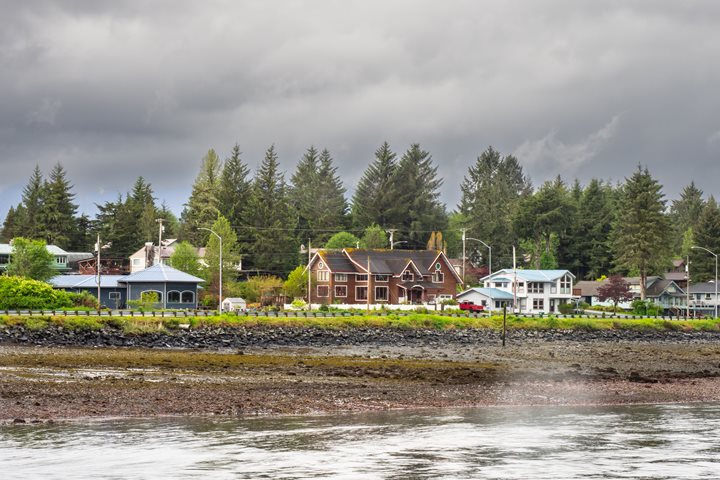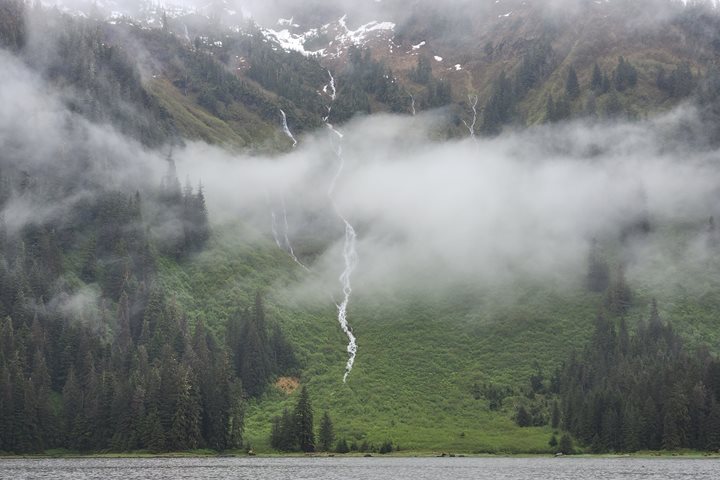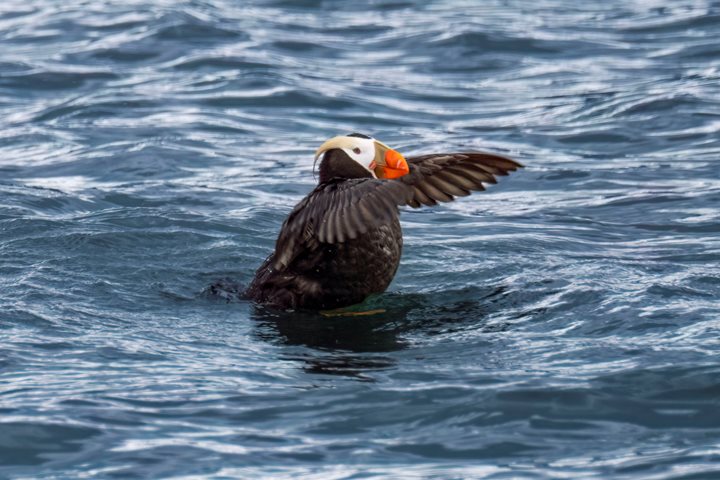National Geographic Sea Lion continued her northerly passage in Tarr Inlet throughout the night and very early this morning. Just before sunrise she was at the northern end of Composite Island and the first views of Mount Fairweather, at over 15,000 feet in height, glowed in the first hint of sunrise light. A healthy portion of our fellow travelers arrived on the bow by 5:30am, in hopes of a spectacular sunrise, and it was beginning wonderfully. A common occurrence in Glacier Bay is the pushing of clouds away from the outer coast Fairweather Mountain Range, opening up clear skies and phenomenal views of some of the most glorious mountain and glacier viewing in North America. This was our luck this morning.
Slowly, the crowd on the bow increased as we made our way around Jaw Point and the first looks of Johns Hopkins Inlet and Glacier came into view. The mountains behind the face of Johns Hopkins were alive in brilliant white from the early morning sun. Just below, a river of ice poured, pulled down by gravity to the face of Johns Hopkins Glacier; a classic example of a tidewater glacier. The inlet leading to the glacier is five-and-a-half miles of sheer beauty! At every turn each of us could find yet another striking piece of raw natural land that is remote, dynamic and intact...and, our good fortune to photograph and hold in a moment of wonder.
Glacier Bay is a homeland, a renewed relationship with the Tlingit people; it is a natural lab, a wilderness, a national park, a united biosphere reserve and a world heritage site. A very short 250 years ago this remarkable body of water and land was covered in an enormous river of ice, approximately 100 miles long and thousands of feet deep. One hundred years ago when John Muir first explored and fell in love with this great land the ice extended to the southern end of Russell Island, a forty mile retreat. Today the ice has retreated more than sixty miles and the land has rebounded between 19 and 22 feet. Plants and animals have returned to the once lifeless, barren rock, repopulating Glacier Bay with a great diversity of life!
Our visit was more or less a reverse botany/colonizing time tunnel, taking us just before dawn and the face of Johns Hopkins Glacier, a river of ice, surrounded by mountains, south down Tarr Inlet seeing the slow and steady advance of life returning after glacial retreat. Birds, bears, mountain goats, hoary marmots, salmon all have returned undisturbed, unencumbered by man’s influence as natural organisms have done for many, many generations. Early stages of an emerging temperate rain forest, grow slowly, showing us Sitka alders, cottonwoods and sparsely placed Sitka spruce; some of the variety of trees that are only a small part of the primary succession of this botanical ecosystem. Underneath these trees and shrubs earlier plants laid down the beginning soil profile so these trees could colonize into a new and emerging forest.
Sea Lion continued south making a stop at Gloomy Knob; we watched mountain goats, bald eagles, surf scoters and a very colorful hoary marmot. Clouds gathered overhead, the light softened and we continued south, heading for our final stop at South Marble Island, a haul-out for Stellar sea lions and a well known bird colony. As our ship approached many tufted puffins were in the middle of their late afternoon bath. Common murres, pelagic cormorants, kittiwake gulls and black oystercatchers were all returning to roost for the evening. In and amongst the many birds were Stellar sea lions. Long, low roaring could be heard from many areas of South Marble over still waters.
Out in Tarr Inlet a double rainbow was glowing over the water...yet another day filled with visual feasts had slipped by rapidly! As we moved from recap to dinner, knowing our time and light were limited, we carried word, thought and image away from a place that belonged to us all; a National Park, a truly American phenomena that had been ours for the day.
“Below us was the Great Land. Indeed, all Glacier Bay is the Great Land, unique, wild and magnificent. It should exist intact solely for its own sake. No justification, rationale, or excuse is needed. For its own sake and no other reason.” -- David Bohn, Glacier Bay; The Land and the Silence







